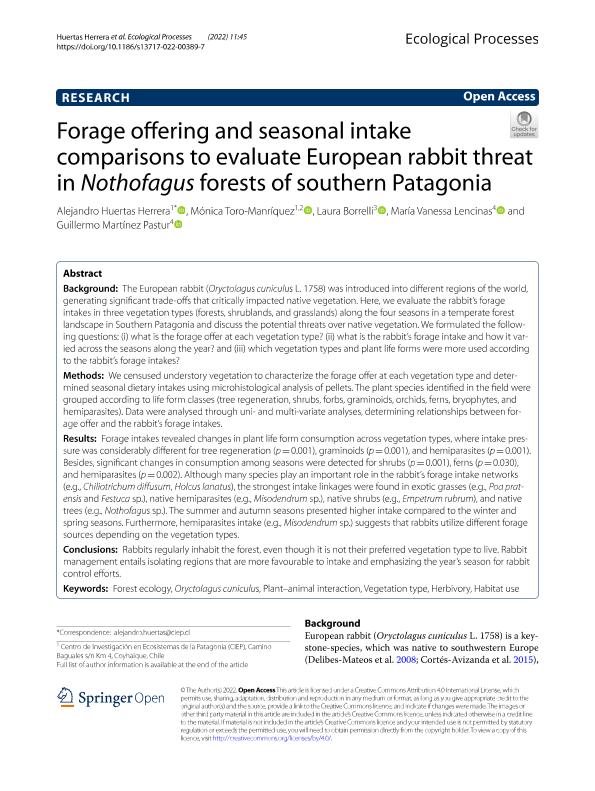Mostrar el registro sencillo del ítem
dc.contributor.author
Huertas Herrera, Alejandro

dc.contributor.author
Toro Manríquez, Mónica del Rosario

dc.contributor.author
Borrelli, Laura Beatriz

dc.contributor.author
Lencinas, María Vanessa

dc.contributor.author
Martínez Pastur, Guillermo José

dc.date.available
2023-09-18T11:42:54Z
dc.date.issued
2022-12
dc.identifier.citation
Huertas Herrera, Alejandro; Toro Manríquez, Mónica del Rosario; Borrelli, Laura Beatriz; Lencinas, María Vanessa; Martínez Pastur, Guillermo José; Forage offering and seasonal intake comparisons to evaluate European rabbit threat in Nothofagus forests of southern Patagonia; Springer; Ecological Processes; 11; 1; 12-2022; 1-14
dc.identifier.issn
2192-1709
dc.identifier.uri
http://hdl.handle.net/11336/211755
dc.description.abstract
Background: The European rabbit (Oryctolagus cuniculus L. 1758) was introduced into different regions of the world, generating significant trade-offs that critically impacted native vegetation. Here, we evaluate the rabbit's forage intakes in three vegetation types (forests, shrublands, and grasslands) along the four seasons in a temperate forest landscape in Southern Patagonia and discuss the potential threats over native vegetation. We formulated the following questions: (i) what is the forage offer at each vegetation type? (ii) what is the rabbit's forage intake and how it varied across the seasons along the year? and (iii) which vegetation types and plant life forms were more used according to the rabbit's forage intakes? Methods: We censused understory vegetation to characterize the forage offer at each vegetation type and determined seasonal dietary intakes using microhistological analysis of pellets. The plant species identified in the field were grouped according to life form classes (tree regeneration, shrubs, forbs, graminoids, orchids, ferns, bryophytes, and hemiparasites). Data were analysed through uni- and multi-variate analyses, determining relationships between forage offer and the rabbit's forage intakes. Results: Forage intakes revealed changes in plant life form consumption across vegetation types, where intake pressure was considerably different for tree regeneration (p = 0.001), graminoids (p = 0.001), and hemiparasites (p = 0.001). Besides, significant changes in consumption among seasons were detected for shrubs (p = 0.001), ferns (p = 0.030), and hemiparasites (p = 0.002). Although many species play an important role in the rabbit's forage intake networks (e.g., Chiliotrichum diffusum, Holcus lanatus), the strongest intake linkages were found in exotic grasses (e.g., Poa pratensis and Festuca sp.), native hemiparasites (e.g., Misodendrum sp.), native shrubs (e.g., Empetrum rubrum), and native trees (e.g., Nothofagus sp.). The summer and autumn seasons presented higher intake compared to the winter and spring seasons. Furthermore, hemiparasites intake (e.g., Misodendrum sp.) suggests that rabbits utilize different forage sources depending on the vegetation types. Conclusions: Rabbits regularly inhabit the forest, even though it is not their preferred vegetation type to live. Rabbit management entails isolating regions that are more favourable to intake and emphasizing the year's season for rabbit control efforts.
dc.format
application/pdf
dc.language.iso
eng
dc.publisher
Springer

dc.rights
info:eu-repo/semantics/openAccess
dc.rights.uri
https://creativecommons.org/licenses/by/2.5/ar/
dc.subject
FOREST ECOLOGY
dc.subject
HABITAT USE
dc.subject
HERBIVORY
dc.subject
ORYCTOLAGUS CUNICULUS
dc.subject
PLANT–ANIMAL INTERACTION
dc.subject
VEGETATION TYPE
dc.subject.classification
Silvicultura

dc.subject.classification
Agricultura, Silvicultura y Pesca

dc.subject.classification
CIENCIAS AGRÍCOLAS

dc.title
Forage offering and seasonal intake comparisons to evaluate European rabbit threat in Nothofagus forests of southern Patagonia
dc.type
info:eu-repo/semantics/article
dc.type
info:ar-repo/semantics/artículo
dc.type
info:eu-repo/semantics/publishedVersion
dc.date.updated
2023-06-30T15:26:08Z
dc.journal.volume
11
dc.journal.number
1
dc.journal.pagination
1-14
dc.journal.pais
Alemania

dc.journal.ciudad
Berlín
dc.description.fil
Fil: Huertas Herrera, Alejandro. Consejo Nacional de Investigaciones Científicas y Técnicas. Centro Austral de Investigaciones Científicas; Argentina. Centro de Investigacion En Ecosistemas de la Patagonia (ciep);
dc.description.fil
Fil: Toro Manríquez, Mónica del Rosario. Centro de Investigacion En Ecosistemas de la Patagonia (ciep); . Consejo Nacional de Investigaciones Científicas y Técnicas. Centro Austral de Investigaciones Científicas; Argentina
dc.description.fil
Fil: Borrelli, Laura Beatriz. Instituto Nacional de Tecnología Agropecuaria. Centro Regional Patagonia Norte. Estación Experimental Agropecuaria San Carlos de Bariloche; Argentina
dc.description.fil
Fil: Lencinas, María Vanessa. Consejo Nacional de Investigaciones Científicas y Técnicas. Centro Austral de Investigaciones Científicas; Argentina
dc.description.fil
Fil: Martínez Pastur, Guillermo José. Consejo Nacional de Investigaciones Científicas y Técnicas. Centro Austral de Investigaciones Científicas; Argentina
dc.journal.title
Ecological Processes
dc.relation.alternativeid
info:eu-repo/semantics/altIdentifier/doi/http://dx.doi.org/10.1186/s13717-022-00389-7
dc.relation.alternativeid
info:eu-repo/semantics/altIdentifier/url/https://ecologicalprocesses.springeropen.com/articles/10.1186/s13717-022-00389-7
Archivos asociados
